Intel Xeon E Six-Core Review: E-2186G, E-2176G, E-2146G, and E-2136 Tested
by Ian Cutress on November 5, 2018 12:00 PM EST- Posted in
- CPUs
- Intel
- Xeon
- Enterprise CPUs
- Xeon E
CPU Performance: Web and Legacy Tests
While more the focus of low-end and small form factor systems, web-based benchmarks are notoriously difficult to standardize. Modern web browsers are frequently updated, with no recourse to disable those updates, and as such there is difficulty in keeping a common platform. The fast paced nature of browser development means that version numbers (and performance) can change from week to week. Despite this, web tests are often a good measure of user experience: a lot of what most office work is today revolves around web applications, particularly email and office apps, but also interfaces and development environments. Our web tests include some of the industry standard tests, as well as a few popular but older tests.
We have also included our legacy benchmarks in this section, representing a stack of older code for popular benchmarks.
All of our benchmark results can also be found in our benchmark engine, Bench.
WebXPRT 3: Modern Real-World Web Tasks, including AI
The company behind the XPRT test suites, Principled Technologies, has recently released the latest web-test, and rather than attach a year to the name have just called it ‘3’. This latest test (as we started the suite) has built upon and developed the ethos of previous tests: user interaction, office compute, graph generation, list sorting, HTML5, image manipulation, and even goes as far as some AI testing.
For our benchmark, we run the standard test which goes through the benchmark list seven times and provides a final result. We run this standard test four times, and take an average.
Users can access the WebXPRT test at http://principledtechnologies.com/benchmarkxprt/webxprt/
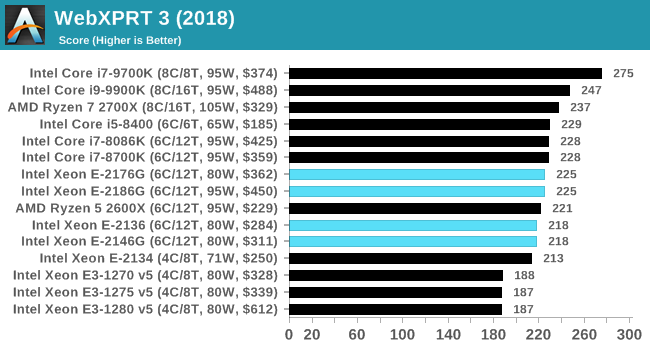
WebXPRT 2015: HTML5 and Javascript Web UX Testing
The older version of WebXPRT is the 2015 edition, which focuses on a slightly different set of web technologies and frameworks that are in use today. This is still a relevant test, especially for users interacting with not-the-latest web applications in the market, of which there are a lot. Web framework development is often very quick but with high turnover, meaning that frameworks are quickly developed, built-upon, used, and then developers move on to the next, and adjusting an application to a new framework is a difficult arduous task, especially with rapid development cycles. This leaves a lot of applications as ‘fixed-in-time’, and relevant to user experience for many years.
Similar to WebXPRT3, the main benchmark is a sectional run repeated seven times, with a final score. We repeat the whole thing four times, and average those final scores.
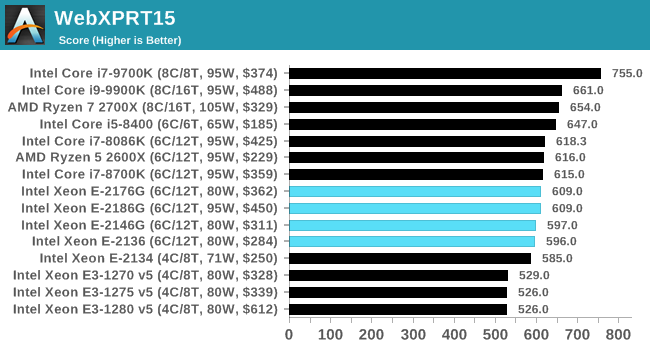
Speedometer 2: JavaScript Frameworks
Our newest web test is Speedometer 2, which is a accrued test over a series of javascript frameworks to do three simple things: built a list, enable each item in the list, and remove the list. All the frameworks implement the same visual cues, but obviously apply them from different coding angles.
Our test goes through the list of frameworks, and produces a final score indicative of ‘rpm’, one of the benchmarks internal metrics. We report this final score.
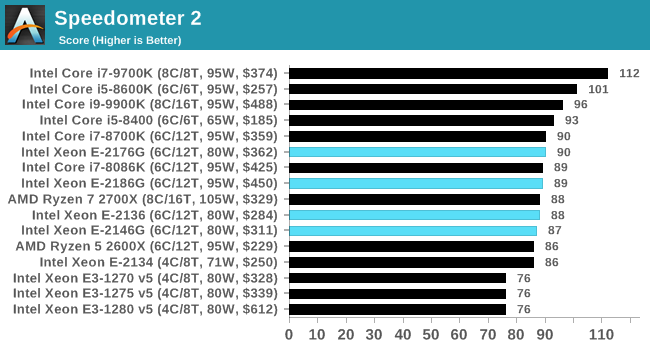
Google Octane 2.0: Core Web Compute
A popular web test for several years, but now no longer being updated, is Octane, developed by Google. Version 2.0 of the test performs the best part of two-dozen compute related tasks, such as regular expressions, cryptography, ray tracing, emulation, and Navier-Stokes physics calculations.
The test gives each sub-test a score and produces a geometric mean of the set as a final result. We run the full benchmark four times, and average the final results.
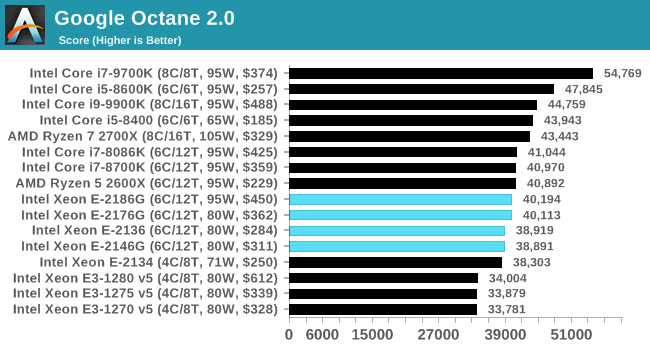
Mozilla Kraken 1.1: Core Web Compute
Even older than Octane is Kraken, this time developed by Mozilla. This is an older test that does similar computational mechanics, such as audio processing or image filtering. Kraken seems to produce a highly variable result depending on the browser version, as it is a test that is keenly optimized for.
The main benchmark runs through each of the sub-tests ten times and produces an average time to completion for each loop, given in milliseconds. We run the full benchmark four times and take an average of the time taken.
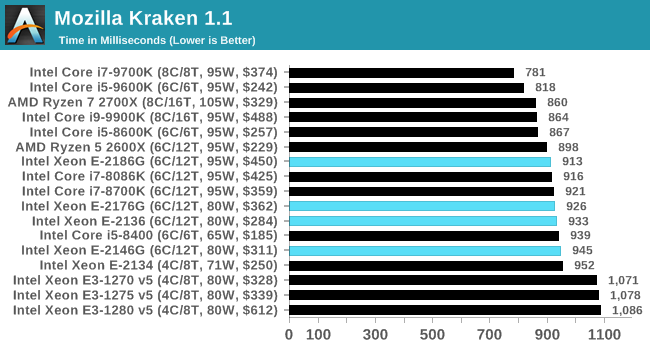
3DPM v1: Naïve Code Variant of 3DPM v2.1
The first legacy test in the suite is the first version of our 3DPM benchmark. This is the ultimate naïve version of the code, as if it was written by scientist with no knowledge of how computer hardware, compilers, or optimization works (which in fact, it was at the start). This represents a large body of scientific simulation out in the wild, where getting the answer is more important than it being fast (getting a result in 4 days is acceptable if it’s correct, rather than sending someone away for a year to learn to code and getting the result in 5 minutes).
In this version, the only real optimization was in the compiler flags (-O2, -fp:fast), compiling it in release mode, and enabling OpenMP in the main compute loops. The loops were not configured for function size, and one of the key slowdowns is false sharing in the cache. It also has long dependency chains based on the random number generation, which leads to relatively poor performance on specific compute microarchitectures.
3DPM v1 can be downloaded with our 3DPM v2 code here: 3DPMv2.1.rar (13.0 MB)
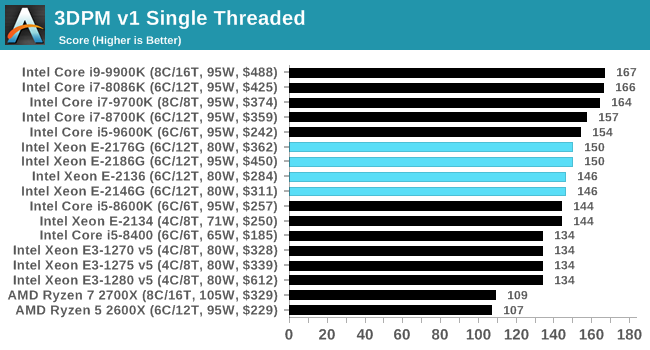
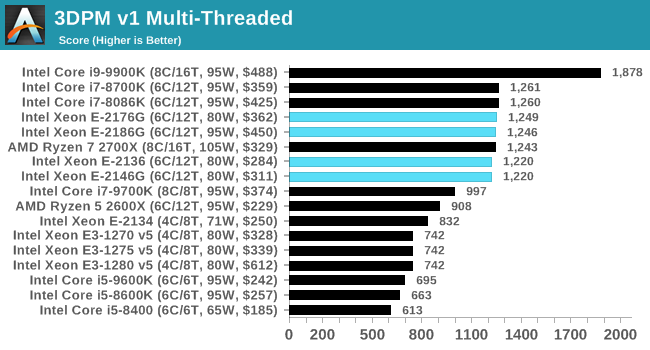
x264 HD 3.0: Older Transcode Test
This transcoding test is super old, and was used by Anand back in the day of Pentium 4 and Athlon II processors. Here a standardized 720p video is transcoded with a two-pass conversion, with the benchmark showing the frames-per-second of each pass. This benchmark is single-threaded, and between some micro-architectures we seem to actually hit an instructions-per-clock wall.

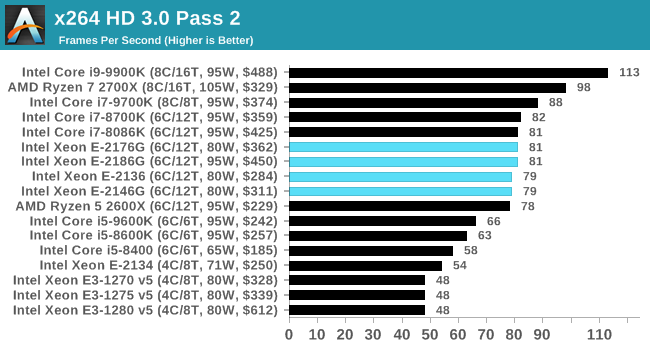










48 Comments
View All Comments
unsleepable - Thursday, November 8, 2018 - link
Any word on the lower-power members of the family? I imagine Intel will still release equivalents to previous generation processors like the Xeon E3-1260L v5, or counterparts to the i7 T CPUs like the Core i7-8700T, right?Chaitan - Saturday, November 10, 2018 - link
There is an interesting statement for these CPUs on ark: "Support for up to 128GB system memory capacity will be available in 2019 through a published BIOS Update. Please contact your hardware provider for availability and support."Does it mean that these will be the first mainstream CPUs with officially provided microcode for Intel memory controller to support 128GB?
Laptops with 128GB RAM support were announced several months ago by Dell, Lenovo and MSI (the latter with desktop CPUs and C246 chipset), but so far CPUs and BIOS for these laptops require custom OEM-specific CPU microcode for memory controller to really support such capacity.
Madao - Saturday, November 10, 2018 - link
I got lucky; got a 2176G on my doorstep from Provantage like Oct 20 for $330. X11SCA-W was in stock on newegg at the same time. I wanted the cheaper ASUS board but it was in stock nowhere.Really pisses me off that AMD and mobo makers dropped the ball on ECC. It should be standard in all computers and even phones. It only needs a few extra ram traces ffs --;
rannyjohns - Thursday, November 15, 2018 - link
I love your blog. And I always find something new here that I either hadn’t seen before or somehow managed to pass over. Thank you for this post! I am recently hoping to reach out and build my network in order to have more of a true collaboration going on, try more solution withasgehrj - Friday, December 14, 2018 - link
I'm not sure I agree that the only reason to get the top model is bragging rights.Agreed, turbo speed is very close to the lower end models, but:
It can sustain a 15% faster base clock than the lower end models, which is meaningful in e.g. render time. (It would almost equal an imaginary 7 core 2136)
"So buy a cpu with more cores" I hear you say...
True in most cases, but I'm building a 3D workstation, where the CAD application likes high single core clock speed , which is hard to find in the models with even more cores. The same machine also does the rendering, so in this case I'm pretty sure the 2186G (or the ..76G) is the better choice.